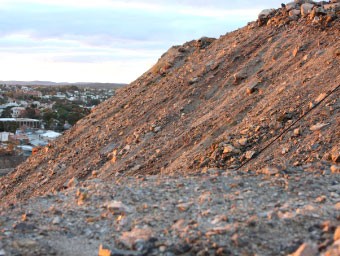Back
Broken Hill Ore Deposit
布罗肯希尔矿床

Broken Hill township is dominated by manmade mullock heaps
布罗肯希尔城镇周围有很多开采后留下的废石堆
The Broken Hill Ore Deposit, arguably the world's richest and largest zinc-lead deposit, was discovered in 1883 by boundary rider Charles Rasp, who found the gossan (weathered sulphide outcrops of massive lead-zinc sulphides). Rasp reported finding massive galena, sphalerite, cerussite and other oxide minerals. His reports (believed exaggerated at the time) of masses of lead in the desert soon proved true and sparked a “lead rush similar to the gold rush. The Broken Hill Ore body is hosted within the gneisses (rock formed by high-grade regional metamorphic processes) of the Willyama Supergroup. The deposit is considered to be appromately 1800 mya.
1883年由牧场巡边工查尔斯·拉斯普发现的布罗肯希尔矿床,是世界上最丰富,面积最大的锌铅矿床。拉斯普首先发现了铁帽(即:风化硫化物露头的块状铅锌硫化物),之后发现了大量方铅矿、闪锌矿、白蜡石和其他氧化矿物。他报告说这块沙漠中含有大量铅物质,一开始被认为言过其实,但是后来很快被证实其真实性,并引发了不逊于“淘金热” 的“淘铅热”。布罗肯希尔矿床存在于维利亚玛岩石组群的片麻岩(高度区域性变质作用下形成的岩石)之中,大约形成于18亿年前。

